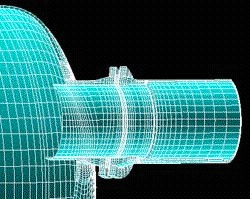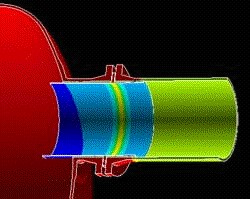FCL's thermal analysis capabilities allow complex transient or steady state temperature distributions to be evaluated by classical and/or finite element analysis methods. Work is often carried out in support of mechanical design or structural integrity assessment activities when knowledge of steady state and/or transient temperature distributions is required in order to facilitate prediction of thermal stress levels. Thermal analysis is also carried out in its own right to substantiate thermal performance or to demonstrate, for instance, that metal temperatures do not fall below levels at which brittle fracture could occur.

In one typical example of such work, FCL have assessed the suitability of thermal sleeves provided at process nozzles on a High Pressure Knock-Out Drum which is periodically subjected to low temperature vapour flow during controlled blowdown.
The specific aim of the work was to establish whether the proposed sleeve design was able to limit thermal stresses arising from temperature differentials set up in the nozzle assembly in the presence of vapour temperatures of -100°C.

Although similar work carried out by FCL has concentrated on the ability of thermal sleeve designs to maintain metal temperatures above minimum permissible levels, such work was unnecessary in this case as the vessel was constructed from stainless steel.
FCL's first task was to establish heat transfer coefficients to characterise the thermal conditions prevailing on the vessel interior and exterior surfaces, which was achieved by use of process data provided by FCL's client, including blowdown flow rates and thermophysical properties and anticipated environment temperatures. Subsequent work included development of a three-dimensional finite element model of the nozzle assembly which was used to determine temperature distributions during the blowdown transient and thermal stresses arising as result of the temperature differentials found.
Consideration of the magnitude of predicted thermal stresses together with those arising due to internal pressure and externally applied piping loads showed that such stresses could be readily accommodated within the available design margins.
The work was completed by preparation of a detailed report which was approved without comment by the client’s certifying authority.